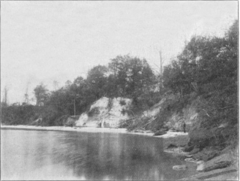Raritan Formation
| Raritan Formation | |
|---|---|
| Stratigraphic range: Turonian | |
 Outcrop of the Raritan Formation near Rocky Point above Round Bay, Severn River, Anne Arundel County, Maryland | |
| Type | Sedimentary |
| Unit of | Potomac Group |
| Sub-units | Raritan Fire Clay, Farrington Sand Member, Woodbridge Clay Member, Sayreville Sand Member, South Amboy Fire Clay Member |
| Underlies | Magothy Formation |
| Overlies | Newark Supergroup, Patapsco Formation |
| Location | |
| Region | New Jersey, New York, Maryland |
| Country | USA |
| Type section | |
| Named for | Raritan Bay |
| Named by | William Bullock Clark (1893)[1] |
The Raritan Formation is a Cretaceous (Turonian) sedimentary geologic formation of the Atlantic Coastal Plain.
Overview
The formation is described in the USGS publication Tolchester folio, Maryland (1917) as follows:
- The formation consists of diverse materials similar to those composing the Patapsco formation, except that, in general, the clays are not so highly colored. White and buff sands; stratified light chocolate-colored sandy clays, in places containing leaf impressions; light-colored argillaceous sands and sandy clays (Fuller's earth); and white, yellow, drab, bluish-drab, and variegated clays all occur in deposits of this age. The variegated clays are well exposed in the steep bluff at Worton Point (see photo below). The delicate pinkish tints which they present at many places have given rise to the local name "peach-blossom clays."[2]
- Vertically jointed clay of Raritan Formation in wave-cut cliff, Worton Point, Kent County (c. 1917)
- The White Rocks off of Rock Point in Anne Arundel County are composed of lithified sands of the Raritan Formation (c. 1917)
Fossils
Dinosaur remains are among the fossils that have been recovered from the formation, although none have yet been referred to a specific genus.[3] A tyrannosauroid similar to Appalachiosaurus is known from the formation.[4]
Many plant fossils have been recovered from the Raritan.[1] The formation hosts the New Jersey Amber deposits.
See also
References
- ^ a b Berry, Edward Wilber (1911). The Flora of the Raritan Formation. Trenton, New Jersey: Geological Survey of New Jersey.
- ^ Miller, B.L.; Mathews, E.B.; Bibbins, A.B.; Little, H.P. (1917). Tolchester folio, Maryland (Report). Folios of the Geologic Atlas. U.S. Geological Society. doi:10.3133/gf204. hdl:1969.1/3671. ISBN 0607728965.
- ^ Weishampel, David B.; Dodson, Peter; Osmólska, Halszka (2004). "Dinosaur distribution". The Dinosauria, 2nd edition. Berkeley: University of California Press. pp. 517–607. ISBN 0-520-24209-2.
- ^ Brownstein, Chase D. (2018-02-08). "The biogeography and ecology of the Cretaceous non-avian dinosaurs of Appalachia". Palaeontologia Electronica. 21 (1): 1–56. doi:10.26879/801. ISSN 1094-8074.
- Weishampel, David B.; Dodson, Peter; Osmólska, Halszka (2004), The Dinosauria, 2nd edition, Berkeley: University of California Press, pp. 1–880, ISBN 0-520-24209-2, retrieved 2019-02-21


